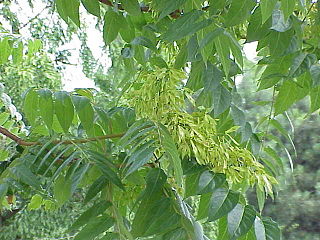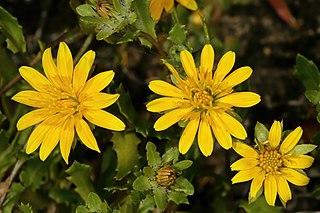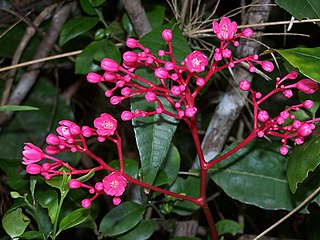
Quassia is a plant genus in the family Simaroubaceae. Its size is disputed; some botanists treat it as consisting of only one species, Quassia amara from tropical South America, while others treat it in a wide circumscription as a pantropical genus containing up to 40 species of trees and shrubs.

The Simaroubaceae are a small, mostly tropical, family in the order Sapindales. In recent decades, it has been subject to much taxonomic debate, with several small families being split off. A molecular phylogeny of the family was published in 2007, greatly clarifying relationships within the family. Together with chemical characteristics such as the occurrence of petroselinic acid in Picrasma, in contrast to other members of the family such as Ailanthus, this indicates the existence of a subgroup in the family with Picrasma, Holacantha, and Castela.

Quassia amara, also known as amargo, bitter-ash, bitter-wood, or hombre grande is a species in the genus Quassia, with some botanists treating it as the sole species in the genus. The genus was named by Carl Linnaeus who named it after the first botanist to describe it: the Surinamese freedman Graman Quassi. Q. amara is used as insecticide, in traditional medicine and as additive in the food industry.

Pittosporum is a genus of about 250 species of flowering plants in the family Pittosporaceae. Plants in the genus Pittosporum are shrubs or trees with leaves arranged alternately along the stems. The flowers are arranged singly or in cymes, with white to yellow petals fused at the base forming a short tube, with stamens that are free from each other. The fruit is a capsule with a single locule that opens to reveal angular seeds.

Pulicaria is a genus of flowering plant in the sunflower family, native to Europe, Asia, and Africa. In North America Pulicaria is known by the common name false fleabane.

Corymbia gummifera, commonly known as red bloodwood, is a species of tree, rarely a mallee, that is endemic to eastern Australia. It has rough, tessellated bark on the trunk and branches, lance-shaped adult leaves, flower buds in groups of seven, creamy white flowers and urn-shaped fruit.
Hannoa is a genus of plant in the family Simaroubaceae. Found in tropical parts of Africa.
Pierreodendron is a genus of plants in the family Simaroubaceae.

Eleusine is a genus of Asian, African, and South American plants in the grass family, sometimes called by the common name goosegrass. One species, Eleusine indica, is a widespread weed in many places. Another species, Eleusine coracana, is finger millet, cultivated as a cereal grain in India and parts of Africa.

Aegiceras is a genus of trees and shrubs from Southeast Asia, Malesia, Australia and the Pacific Island,. and in Australia, in the Northern Territory, Queensland, New South Wales, and Western Australia. They occur as mangroves in coastal or estuarine areas.
Disparago is a genus of flowering plants in the family Asteraceae.

Cuspidia is a genus of flowering plants in the family Asteraceae.

Simarouba is a genus of trees and shrubs in the family Simaroubaceae, native to the neotropics. It has been grouped in the subtribe Simaroubina along with the Simaba and Quassia genera. They have compound leaves, with between 1 and 12 pairs of alternate pinnate leaflets. Their flowers are unisexual, relatively small and arranged in large panicles. Plants are dioecious, bearing only male or female flowers. The individual flowers have between 4 and 6 sepals and petals and between 8 and 12 stamens. The fruit is a carpophore and has up to 5 drupaceous mericarps.

Castela emoryi, with the common names crucifixion thorn, Emory's crucifixion-thorn, and Spanish: chaparro amargosa, is a shrub species in the genus Castela of the family Simaroubaceae.

Antifeedants are organic compounds produced by plants to repel herbivores through distaste or toxicity. These chemical compounds are typically classified as secondary metabolites in that they are not essential for the metabolism of the plant, but instead confer longevity. Antifeedants exhibit a wide range of activities and chemical structures as biopesticides. Examples include rosin, which inhibits attack on trees, and many alkaloids, which are highly toxic to specific insect species, such as quassinoids against the diamondback moth. Samadera indica also has quassinoids used for insect antifeedant uses.

Quassinoids are degraded triterpene lactones of the Simaroubaceae plant family grouped into C-18, C-19, C-20, C-22 and C-25 types. The prototypical member of the group, quassin, was first described in the 19th century from plants of the genus Quassia from which it gets its name. It was isolated in 1937, and its structure elucidated in 1961.
Samadera harmandiana is a freshwater mangrove shrub or small tree in the Simaroubaceae family. It is found in Cambodia, Laos and Vietnam. The wood provides firewood. Certain fish eat the poisonous fruit

Simaba is a genus of flowering plants belonging to the family Simaroubaceae.

Samadera indica, the bitter wood or Niepa bark tree, is a species of plant in the family Simaroubaceae. It is a shrub or tree and grows primarily in wet tropical regions, from west Africa, through India, then down through Indonesia to Malesia.
Simaba borneensis is a plant in the family Simaroubaceae. It is native to Borneo and Sumatra.














